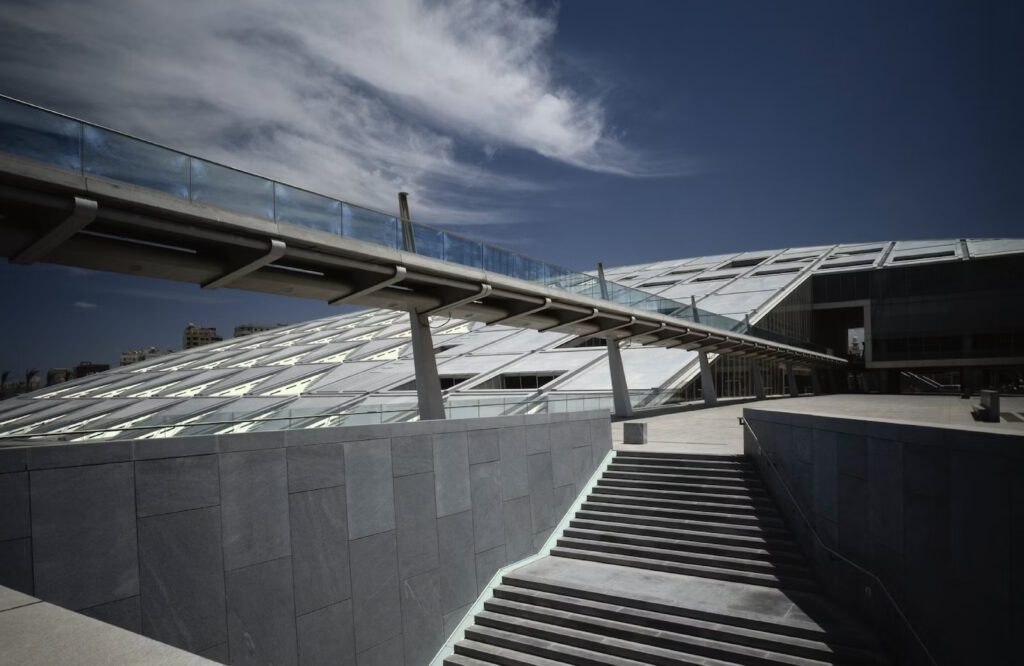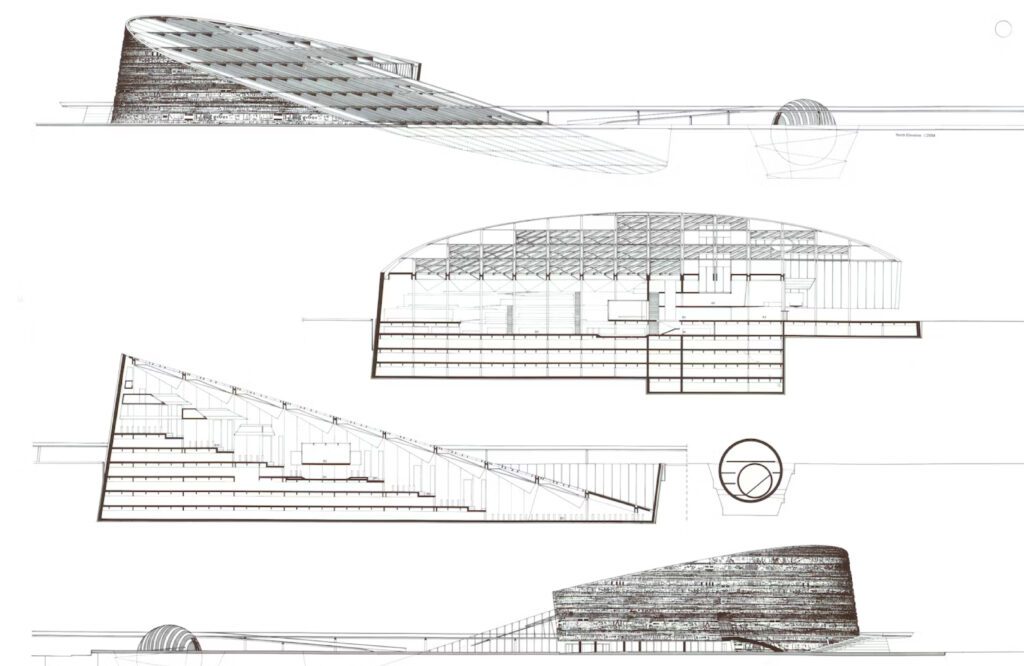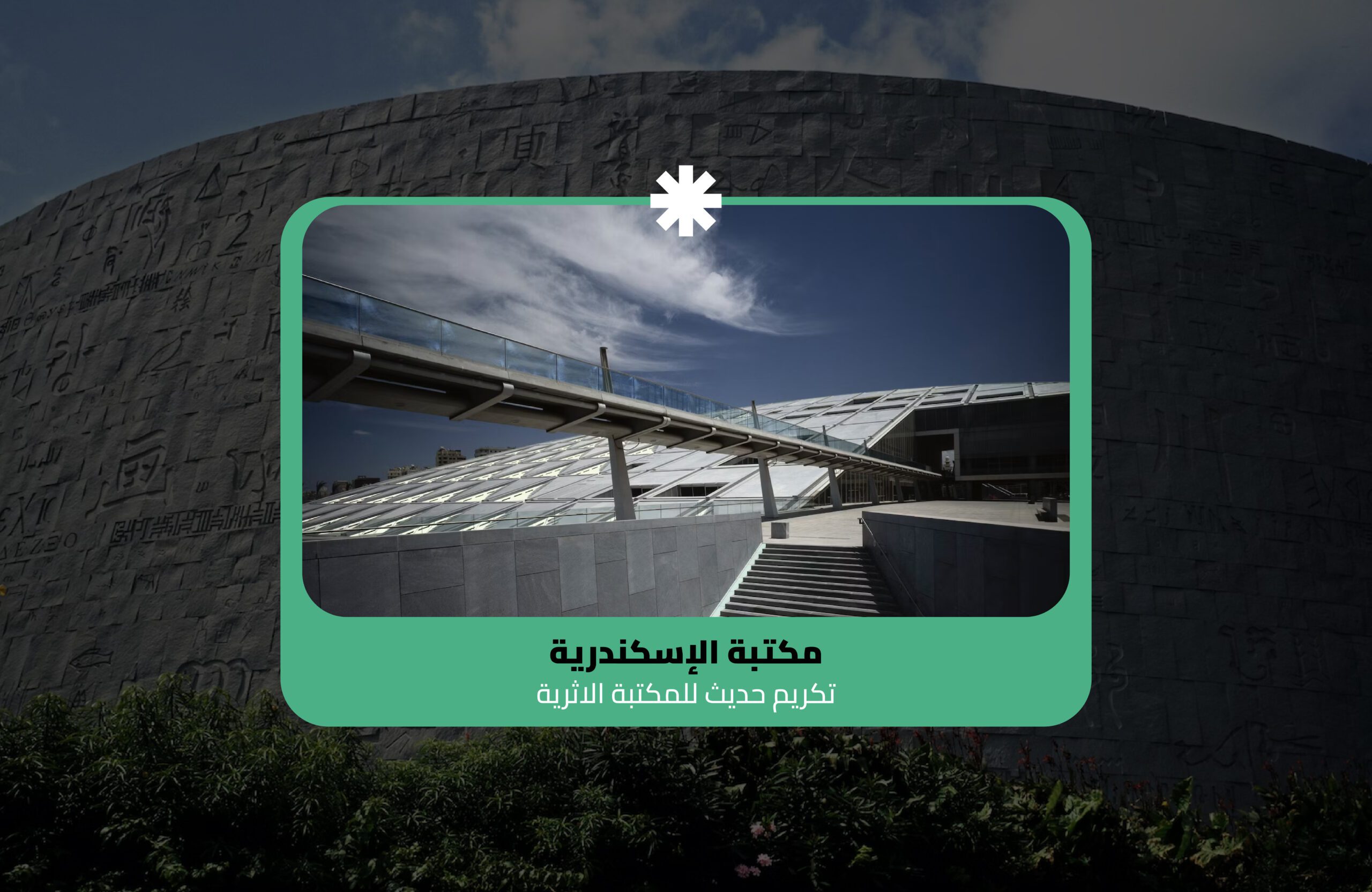The Bibliotheca Alexandrina, or the “Library of Alexandria,” is a remarkable institution that stands as a testament to Alexandria’s rich cultural and intellectual heritage. It was inaugurated in 2002 and seeks to revive the spirit of the ancient Library of Alexandria while embracing modern knowledge and technology. The library is no longer just a place for books but a dynamic hub for education, research, and cultural exchange. It represents the city’s rich history and commitment to fostering intellectual curiosity.

Historical Background of Bibliotheca Alexandrina
The original Library of Alexandria was established in the 3rd century BCE and was one of the most significant learning centers in the ancient world. It housed numerous scrolls and attracted scholars, scientists, and philosophers from all over the Mediterranean. Unfortunately, this iconic institution was destroyed, and its loss is considered one of the greatest cultural tragedies in history. The modern Bibliotheca Alexandrina idea was shaped in the late 20th century, aimed to revive its predecessor’s spirit and significantly contribute to the global knowledge landscape.
The Library of Alexandria was part of the research institute at Alexandria, Egypt, known as the Alexandrian Museum or Mouseion, which means “shrine of the Muses.” While archives and libraries were known to various ancient civilizations in Egypt, Syria, Asia Minor, and Greece, Mesopotamia the earliest institutions were primarily concerned with preserving their specific traditions and heritage. The concept of a universal library like that of Alexandria emerged only after the Greek mind began to envision and encompass a larger worldview.
The founding of the library and the Mouseion is closely linked with the name of Demetrius of Phaleron, a member of a former Athenian politician and the Peripatetic school. After he fell from power in Demetrius, Athens, become refuge at the court of King Ptolemy I Soter and became the king’s advisor. Ptolemy soon took advantage of Demetrius’s broad and versatile knowledge and, around 300 BCE, tasked him with founding the library and the Mouseion.
Architectural Marvel:

The Bibliotheca Alexandrina is a truly stunning masterpiece of modern architecture designed by the Norwegian firm Snøhetta. It’s more than just a library; it’s a vibrant cultural centre embodying the city’s history and enduring thirst for knowledge.
A Modern Icon with Historical Echoes The library’s circular form tilted towards the ground, is a powerful symbol of the cyclical nature of knowledge, constantly flowing through time. Its gleaming roof echoes the ancient Alexandrian lighthouse, making it a beacon of learning and culture for the 21st century.
The architects beautifully blend the past and present in the library’s design. John Carl Warneke, chairman of the architectural competition jury, aptly stated: “The form of a circle expresses the basic continuity of man’s existence. The circle symbolises unity and continuity that embraces the past, present, and future.”
A Journey of Planning and Perseverance The Bibliotheca Alexandrina’s journey began in 1989 with an international competition to design a new library for the city. Snøhetta’s winning design faced challenges during construction, with archaeological discoveries of Roman villas and mosaics delaying the process. However, these discoveries ultimately enriched the project, adding layers of history to the site.
Finally, in 2002, after 12 years and $220 million, the doors of this monument to learning were opened. Today, the library pulsates with the energy of an academic powerhouse, hosting 1,500 annual programs and attracting a million visitors every year.
A Sanctuary of Knowledge The heart of the library is its world-renowned reading room, the largest open reading room in the world. This colossal space can accommodate 2,000 readers across seven terraced levels, offering breathtaking views and making knowledge readily accessible.
The library is not just about consuming books; it’s about celebrating the very essence of knowledge. Its exterior façade is a stunning work of art, with nearly 6,000 square metres of hand-carved stone adorned with over 4,000 unique characters from alphabets, musical notations, Braille, and even barcodes. This tapestry of symbols and scripts is a powerful reminder of the diversity of human knowledge and the library’s role as a bridge between cultures.

The exterior wall is also a testament to the fusion of nature and culture. Inspired by ancient geological layers, each stone slab whispers tales of forgotten eras. The project revived forgotten Egyptian stone-carving techniques through a training program for young masons, creating a breathtaking interplay of light and shadow that tells stories etched in stone. The Bibliotheca Alexandrina is not just a monument to the past; it’s a blueprint for the future. Before the green building movement gained momentum, it embraced sustainability with locally sourced materials, natural light, and thermal massing for a comfortable and energy-efficient environment. The surrounding water pool even acts as a natural air purifier.
Snøhetta’s Bibliotheca Alexandrina is more than just a library; it’s a vibrant tapestry of history, culture, and learning. It’s a testament to the enduring human spirit, a phoenix reborn from the ashes of lost knowledge, ready to illuminate the future with the power of the written word. It’s a beacon of hope, a reminder that knowledge can transcend time and borders, forever pushing the boundaries of human understanding.
What is inside Bibliotheca Alexandrina:

The library of Alexandria was one of the most significant institutions of classical times. While it seems like a challenging task to replace it, the new Bibliotheca Alexandrina accomplishes this with great skill. The modern architecture of this impressive building, which opened in 2002, is a deliberate effort to revive the glory of the original centre of learning and culture. The complex is now one of Egypt’s major cultural venues and hosts numerous international performers, as well as being home to a collection of brilliant museums.
The building has the shape of a massive angled discus that is embedded in the ground, resembling a second sun rising out of the Mediterranean. The exterior walls are made of granite and are carved with various letters, pictograms, hieroglyphs, and symbols from over 120 different human scripts. Upon entering the building, visitors will be greeted by the main reading room that can hold up to eight million books and accommodate 2500 readers under its sloping roof. The windows in the room are specially designed to allow sunlight to flood in while keeping out harmful rays that could damage the collection.
In addition to the impressive main reading room, there are four specialised libraries catering to different age groups: a children’s library for ages 6 to eleven year old a youth library for ages 11 to 17, and a library for the blind. You can also find a range of other activities such as four permanent museums, a planetarium, a conference centre, and a variety of temporary and permanent exhibitions, along with a full schedule of events. If you want to explore this attraction fully, you should plan to spend at least half a day there. However, if you just want to admire the stunning main reading room and take a tour, an hour or so should be enough.
The library is right on the sea, but the main entrance is next to the ticket office and both are at the back. you can bring your camera and wallet but all bags must be checked at the ticket office. Two museums inside have individual entrance tickets bought within the building, next to them
The Antiquities Museum has a unique exhibition of old artefacts selected from sites in Egypt all over and they are from the Pharaonic time through to the Greek and Roman times in egypt and into the Byzantine and Islamic eras as well. There’s also a fine collection of 2nd-century coloured funerary masks, intricately decorated mummy cases, blue shabti (funerary statues), and some gorgeous Greek-era statuary.
After visiting the Manuscript Museum and admiring its beautiful collection of ancient texts and antique books, including the only surviving scroll from Alexandria’s ancient library, we headed next door to the Impressions of Alexandria Exhibition. The exhibition did a wonderful job of displaying the city’s precious history through drawings, maps, and early photographs.
here the Bibliotheca’s exhibition halls showcase the work of contemporary Arabic artists and are home to a fascinating heritage collection from gorgeously displayed textiles and folk art, also Arabic science equipment from the mediaeval time. Shadi Abdel Salam (a cult film director, scriptwriter, and set designer born in Alexandria) displays his wonderful drawings. His most well-known film, The Night of Counting the Years (Al Mummia as known in Arabic), and others There’s also the Culturama a video program on Egyptian history called , displayed on nine screens.
The exhibition contains the old machines of the Bulaq Press, the first Egyptian press. Visitors can see, on display, a great number of the old printing presses and their accessories, such as character assembly machines, in addition to samples of printed material. The Bulaq Press was established under the rule of Mohamed Ali in 1820, while the assembling of the machines began in 1821. The first publication by the Press was an Arabic-Italian dictionary issued in 1822. The significance of the Bulaq Press extends far beyond the mere machine: the beacon that guided Egypt out of the dark ages by providing a much-needed source of knowledge in printed books.
You may be interested to visit the Sadat Museum, which is the first museum in Alexandria devoted to the late President Anwar Sadat. The museum spans over an area of 260 square metres and is a part of the BA’s mission to preserve the history of modern Egypt.
Visitors to the museum are treated to a Culturama show about President Sadat before entering. Additionally, 12 hours of video content donated by the Egyptian Television are available for viewing. These include President Sadat’s speeches, reports given by foreign reporters, the movie “Action Biography” about President Anwar Sadat, a display of all the documents on the Egyptian-Israeli peace process and the 6th of October War, and a number of recordings that were never broadcasted before.
Alexandria National Museum features many honours awarded to President Sadat during various stages of his life, in addition to many gold, silver, bronze plates that sadat and Mrs. Jehan Sadat received as gifts.
The museum exhibits President Sadat’s collection of civilian and military suits, medals, and artefacts. Notably, the display includes the blood-stained military suit he wore on the day of his assassination on October 6, 81.
Also on display at the museum is a collection of Sadat’s possessions, such as his radio set and his desk, and his library, which contains a collection of rare books that had been donated to the president. also, visitors will find Sadat’s portraits along with a number of Arabian swords, memorial shields, his cane and his pipe, and the clothes he used to wear whenever he visited his hometown, Mit Abul Kom, in northern Egypt.
Among unique objects donated by Mrs. jihan Sadat are the following:
- Three lanterns Islamic, Christian, and Jewish that sadat recieved during his visit to the holy Jerusalem.
- A recording of the Quran in Sadat’s voice.
- Some papers, including a short story by Sadat written mostly in his handwriting with some parts copied down by his wife.
- A rare collection of visual recordings.
The Planetarium is a futuristic sphere that illuminates the plaza in front of the library, resembling a miniature Death Star from Star Wars. It showcases 3D films that focus on space exploration, the natural world, and Egyptian history, with the aim of educating children on a rotating schedule. Additionally, it houses an Exploratorium and the History of Science Museum underneath, which are targeted towards groups of Egyptian school children. The museum delves into the contribution to science made by three key historical eras – Pharaonic Egypt, Hellenistic Alexandria, and the Islamic era.
For art lovers, The Bibliotheca Alexandrina (BA) Arts Center’s Program features concerts, theatrical performances, film screenings, workshops, seminars, lectures,
art education programs and children’s activities, among others.
Tours of Bibliotheca Alexandrina run every 45 mins 11.45 am and 4.30 pm, Sunday to Thursday, and on Saturdays from 12.10 to 3 pm.
The library has a wide range of kid-friendly activities and diversions, but kids under six are not admitted to the library room. Helpfully, daycare is available during opening hours.
Bibliotheca Alexandrina Role as a Cultural Hub:
Bibliotheca Alexandrina has an important role as a cultural hub, serving as a platform for intellectual exchange, heritage preservation, and arts promotion. The library regularly hosts various cultural events, such as lectures, exhibitions, and performances, creating an environment that fosters creativity. The diverse programs offered by the library attract both local and international audiences, making it a global centre for cultural engagement. Through its cultural initiatives, Bibliotheca Alexandrina plays an active role in promoting cross-cultural understanding and in preserving the rich cultural heritage of Egypt.
Educational Initiatives:
At the forefront of its mission, Bibliotheca Alexandrina is dedicated to advancing education across diverse levels. Through myriad educational initiatives, the library extends its reach to students, researchers, and the broader public. A comprehensive array of educational programs, workshops, and seminars are meticulously crafted to cater to varying interests and learning needs.
Collaborating with academic institutions within Egypt and on the global stage, the library forms strategic partnerships to amplify the impact of its educational endeavours. These collaborations broaden the scope of educational opportunities and foster a culture of continuous learning.
By actively engaging with learners of all backgrounds, Bibliotheca Alexandrina acts as a catalyst for knowledge dissemination and skill development. Its commitment to education is reflected in the diverse range of initiatives designed to inspire intellectual curiosity, encourage research pursuits, and provide valuable resources for both formal and informal learning.
Research and Innovation:
Beyond being a mere repository of books, Bibliotheca Alexandrina stands as a dynamic hub for research and innovation. Within its walls, a plethora of research centres and laboratories are dedicated to an array of disciplines, spanning science, technology, arts, and humanities. These specialised centres serve as vital engines propelling the advancement of knowledge and actively contributing to global research endeavours.
The library’s commitment to innovation is palpable through its investment in state-of-the-art facilities and the incorporation of cutting-edge technologies. Bibliotheca Alexandrina fosters collaboration among experts and scholars from diverse fields by providing a conducive environment for interdisciplinary research. This collaborative spirit accelerates discovery and promotes innovation.
The library’s research and innovation initiatives are designed not only to enhance its own collections and resources but also to make significant contributions to the broader academic and scientific communities. Through fostering a culture of inquiry and discovery, Bibliotheca Alexandrina reaffirms its role as a beacon of intellectual exploration and a catalyst for pushing the boundaries of knowledge across various domains.
Digital Library and Information Technology:
Adapting to the needs of the digital era, Bibliotheca Alexandrina proudly features a robust digital library, granting users access to an extensive array of electronic resources. Serving as a virtual gateway to a wealth of information, the library’s website stands as a portal facilitating online access to a diverse collection of books, journals, and multimedia content. This digital initiative represents a significant evolution, extending the library’s influence and impact far beyond its physical space’s constraints.
Embracing the power of technology, Bibliotheca Alexandrina’s digital library broadens the spectrum of available resources and enhances the accessibility of knowledge on a global scale. Users, regardless of geographical location, can seamlessly explore and engage with the library’s vast digital repository through its user-friendly online platform.
Cultural Heritage Preservation:
Bibliotheca Alexandrina is acutely aware of the significance of preserving cultural heritage, acknowledging that this extends beyond the mere documentation of historical artefacts. The library takes proactive measures to safeguard and promote cultural diversity, recognizing its pivotal role in preserving the rich tapestry of Egypt’s cultural legacy. Engaging in a multifaceted approach, Bibliotheca Alexandrina collaborates with international organisations, spearheads conservation projects, and orchestrates exhibitions that celebrate the depth and diversity of Egypt’s cultural heritage.
Through strategic partnerships with global entities, the library enhances its efforts in cultural heritage preservation, drawing on collective expertise and resources. Conservation projects undertaken by Bibliotheca Alexandrina not only ensure the physical protection of cultural artefacts but also contribute to the broader narrative of Egypt’s historical and cultural significance.
A noteworthy aspect of the library’s commitment is reflected in its vibrant exhibitions, which serve as platforms to showcase the multifaceted aspects of Egypt’s cultural richness. These exhibitions educate the public and foster an appreciation for the diversity that defines the country’s heritage.
International Collaboration:
Bibliotheca Alexandrina has solidified its position as a pivotal hub for international collaboration, strategically forming partnerships with libraries, research institutions, and cultural organisations across the globe. These alliances serve as conduits for the exchange of knowledge, expertise, and resources, creating a platform for a global dialogue on critical issues. The library’s unwavering commitment to openness and inclusivity is manifest in its dedicated efforts to connect cultures and nurture understanding among diverse communities.
By engaging in collaborations with international counterparts, Bibliotheca Alexandrina transcends geographical boundaries, fostering a vibrant exchange of ideas and perspectives. The library’s commitment to creating a global network for intellectual exchange is reflected in the seamless flow of knowledge and the sharing of resources these partnerships facilitate.
Moreover, Bibliotheca Alexandrina’s focus on inclusivity is evident in its attempts to bridge cultural differences and foster mutual understanding.Through these collaborative initiatives, the library catalyses building connections among people from various backgrounds, reinforcing the belief that knowledge and cultural exchange are powerful tools for promoting harmony and unity on a global scale.
Bibliotheca Alexandrina stands as a beacon of intellectual revival, embodying the spirit of the ancient Library of Alexandria while embracing the challenges and opportunities of the contemporary world. Its architectural marvel, educational initiatives, research endeavors, and commitment to cultural heritage preservation position it as a dynamic force in the global knowledge landscape. As Bibliotheca Alexandrina continues to evolve, it pays homage to Alexandria’s rich history and shapes the future of intellectual exploration and cultural exchange on a global scale.



